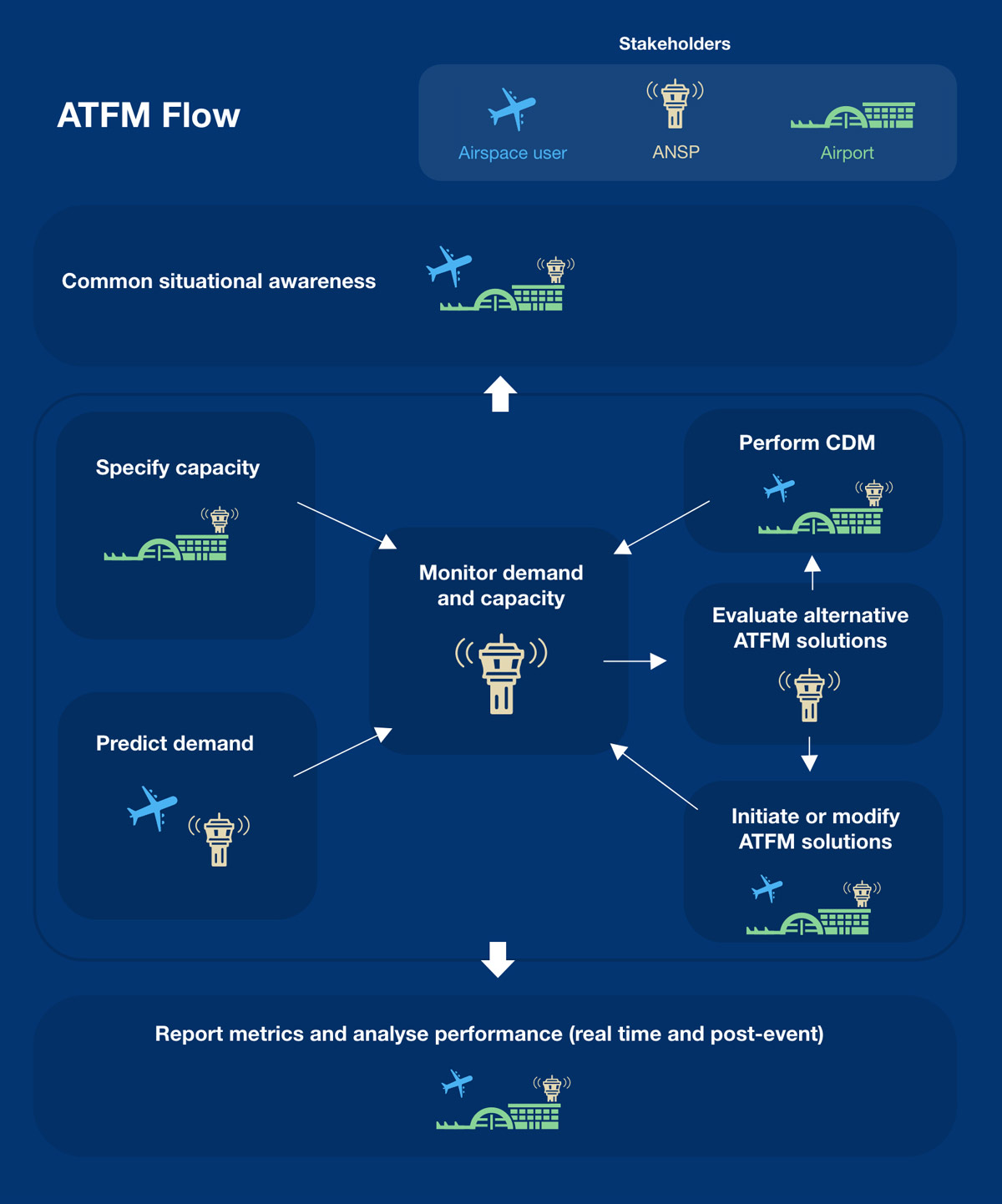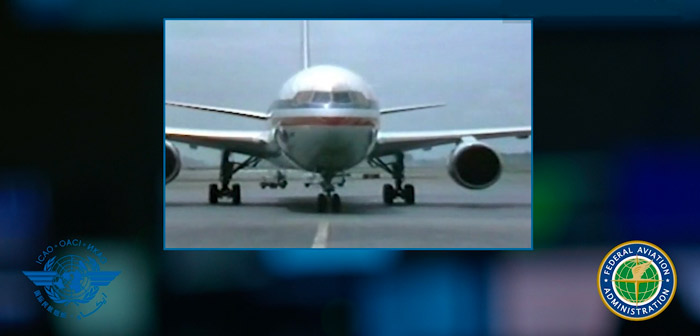Lesson 1: ATFM Overviews
Lesson Outline
- ATFM Mission, Benefits, & Job Functions
- How ATFM Developed
- ANSP Roles and Responsibilities
- Stakeholder Roles and Responsibilities
- Considering Stakeholder Priorities
- Why CDM?
- CDM and ATFM Flow
- ATFM Today and Future
Lesson Objectives
- Understand how and why ATFM developed.
- Define the mission of ATFM.
- Describe the traffic management coordinator’s role in the ATFM flow and process.
- Identify roles and responsibilities of ANSPs and Stakeholders in the airspace system.
- Recall the concepts of demand vs. capacity.
- Understand ATFM’s role in considering stakeholder priorities.
- Name the goal of Collaborative Decision Making (CDM).
1.1: ATFM Mission, Benefits, & Job Functions
Prior to the COVID-19 pandemic, the global air traffic system was accommodating over three and a half billion passengers per year, according to the International Air Transport Association (IATA). As more and more flights resume, managing air traffic in a safe, efficient, environmentally sustainable, and cost-effective manner will be as important as ever.
Air Traffic Flow Management (ATFM) is a system that monitors and adjusts the flow of air traffic, enabling aviation stakeholders to exchange information and make safe, appropriate decisions when air traffic demand exceeds airspace capacity. ATFM is a requirement for Air Navigation Service Providers (ANSPs) under ICAO Annex 11 to the Convention on Civil Aviation for States.
In this lesson, you will learn the basics of ATFM and the Collaborative Decision Making (CDM) process and how together these processes ensure all stakeholders’ needs are considered and the best decisions are made for the air traffic system.
1.1 ATFM Mission, Benefits, & Job Functions
The mission of Air Traffic Flow Management (ATFM) is to balance air traffic demand with system capacity to ensure the safe and efficient utilization of the Airspace System.
What does this mean?
- Air Traffic Demand is the number of flights in operation or planned for that day.
- System Capacity is the number of flights an airspace or airport can safely handle in an hour.
- Many things can impact capacity, such as weather, runway configurations, facility and equipment problems, and staffing.
- Using ATFM, Traffic Management Coordinators (TMCs) safely manage the flow of air traffic to maximize airspace use in a way that doesn’t overwhelm an airport or airspace. Often, this is achieved by implementing restrictions or Traffic Management Measures (TMMs).
- The operational benefits of ATFM include:
- Increases system safety.
- Minimizes delay and congestion.
- Increases throughput.
- Lowers cost through fuel savings.
- Provides scheduling predictability.
- Supports the implementation of new technology and procedures that enhance airspace capacity.
- The five major job functions of ATFM that fulfill the mission are:
- Analyze the impacting conditions
- Develop a plan of action for a given constraint
- Implement restrictions as needed
- Monitor facility initiatives and the overall system—make sure the TMMs are working and giving controllers what they need.
- Document TMMs/actions taken
Timely and accurate information is key—both for determining capacity constraints and for making improvements to the system.
1.2 How ATFM Developed
Several factors led to the development of ATFM in the U.S.
- Airline deregulation, lower passenger ticket prices, and increased business travel led to unmanageable air traffic volume.
- With the 1970s oil crisis, fuel efficiency became crucial. To cut costs, airlines wanted to reduce airborne holding and flight delays. (Previously, airborne holding was a common practice.)
- Air traffic demand was exceeding system capacity.
- The first Ground Delay Program established ATFM in the U.S.
- A Ground Delay Program is a TMM in which aircraft are held on the ground to manage capacity and demand in a specific volume of airspace or at a specific airport/aerodrome.
- Other TMMs include reroutes, miles in trail, minutes in trail, ground stops, and planned airborne holding.
ICAO 9971: Airborne holding may be complementary to ground delay programmes and ground stops. Airspace Users (AUs) may, in collaboration with the ANSP, choose to use this programme to keep a small inventory of holding aircraft during periods of congestion, to maintain demand pressure on the approach. The supply of available aircraft can prevent losing opportunities when departure demand is not constant or when meteorological conditions vary.
- Today, TMCs focus on maximizing safety and airspace use while minimizing the impact of TMMs and delays to individual aircraft.
- It took decades to get to where we are today.
1.3a ANSP Roles and Responsibilities
- The ICAO Manual on Collaborative Air Traffic Flow Management (Doc 9971) describes a variety of roles involved in ATFM. Brief excerpts of this information are provided below.
- Per Doc 9971, Since ATFM structures should be adapted to the challenges in the region where they are implemented, there can be variations in the roles and responsibilities, as described here.
Flight Management Unit (FMU)
- Provides ATFM service for a specific set of Air Traffic Service (ATS) units.
Flight Management Positions (FMP)
- Responsible for the day-to-day ATFM activities.
FMUs/FMPs monitor and balance traffic flows within their areas of responsibility in accordance with Air Traffic Management (ATM) directives. They also direct traffic flows and implement approved traffic management measures (TMMs).
FMU/FMP duties usually include:
- Coordinate with air traffic control (ATC) units, airlines, and other aviation stakeholders.
- Collect and distribute information about weather, capacity constraints, and procedures.
- Collaborate with stakeholders to develop and execute air traffic management plans.
- Create and distribute an ATFM daily plan (ADP).
- Continuously monitor and adjust ATFM measures.
- Document and analyze ATFM performance.
Click to view position descriptions.
FMU Managers supervise FMU staff while effectively collaborating with internal (ACC) staff and external adjacent ACCs and government agencies.
Additional duties:
- Ensure the FMU staff monitors air traffic flows.
- Ensure the FMU staff maintains awareness of conditions that impact demand and capacity.
- Has held an Air Traffic Controller (ATCO) license with one of the following ratings: aerodrome, radar or non-radar approach, or radar or non-radar area.
- Ensure the FMU staff prepares, delivers, and briefs on reports and ATFM Daily Plan (ADP) to adjacent ANSPs and stakeholders concerning the capacity and demand of air traffic control (ATC) sectors, airport acceptance rates (AAR), and airport departure rates (ADR).
Traffic Management Officers (TMOs) / Supervisors ensure that Traffic Management Coordinators (TMCs) implement efficient, effective, and timely traffic management measures within the geographic area of responsibility.
Additional duties:
- Demonstrate a collaborative approach with neighboring flight information regions (FIRs) and stakeholders.
- Evaluate work performance, ensuring equity of performance standards and ratings. Assigns and reviews work.
- Ensure that traffic management measures are initiated and coordinated in accordance with established procedures.
- Possess an ATCO license with one of the following ratings: airport/aerodrome, radar or non-radar approach, or radar or non-radar area.
Traffic Management Coordinators (TMCs) constantly monitor the flow of air traffic, the infrastructure of air navigation services, the conditions of underlying airports, and the current and forecasted weather conditions to assess a facility's capacity and project an acceptable level of traffic.
Additional duties include:
- Enter the ATFM Daily Plan (ADP) into a shareable log and ensures nearby ANSPs are aware. For example, if the ANSP is a member of CADENA, the information would be entered into the CADENA Operational Information System (OIS).
- Avoid flight routes into undesirable weather conditions. In some instances, serves as a military liaison and coordinates with the military regarding exercises and activities within the designated ANSP airspace.
- Use equipment and tools suitable for balancing air traffic demand and capacity in ATC sectors and at applicable underlying airports/aerodromes.
- Possess an ATCO license with one of the following ratings: airport/aerodrome, radar or non-radar approach, or radar or non-radar area.
1.3b Stakeholder Roles and Responsibilities
The main stakeholders in ATFM include airspace users, military users, air traffic service, airports/aerodromes, Meteorological (MET) service providers, and States and State authorities.
Click to view stakeholder descriptions.
Airspace users (AUs) include all entities that make use of airspace and that affect the availability of airspace, including pilots, airlines, general aviation, cargo flight operators, unmanned aerial vehicle operators, and military authorities.)
Responsibilities include:
- Provide strategic input into capacity/demand scenarios and mitigation plans, including internal measures such as schedule compression.
- Provide latest schedule and flight planning information to the ATFM service.
- Participate in ATFM/CDM teleconferences. This process is called Collaborative Decision Making (CDM). CDM will be discussed later in this lesson.
- Provide tactical input into capacity/demand scenarios and the selection of required appropriate ATFM measures.
- Perform mitigating actions supported by the ATFM service.
- Ensure ATFM information (data, i.e. CTOT) is distributed to each affected flight.
- Comply with ATFM measures in place.
- Participate in post-event analyses.
Military users include military authorities, flying units, and non-flying airspace users (such as ranges). Their airspace use ranges from reserving blocks of airspace for specific missions to operating flights like civilian operators. They must coordinate their airspace use with ATFM.
Responsibilities include:
- Providing airspace utilization plans to the appropriate ATC and ATFM units in a timely manner.
- Ensure operations comply with civil/military flexible use of airspace (FUA) plan and advise the appropriate unit immediately of completion or cancellation of FUA operations.
- Supply the latest flight information to ATFM system.
- Ensure flights comply with the ATFM measures in place.
- Coordinate with the ATFM/ATC for tactical release of airspace or permission to fly through restricted/active airspace.
- Participate in ATFM/CDM teleconferences and post-event analyses.
Air Traffic Service (ATS) units play a central role in ATFM. Whereas each unit controls flights at different moments, the roles and responsibilities of ATS units are similar within their specific area of responsibility (aerodrome, approach, area).
Responsibilities include:
- Deliver aircraft as per the ATFM daily plan (ADP), ensuring compliance with ATFM measures.
- Participate in ATFM/CDM teleconferences.
- ATCOs who provide Air Traffic Services should provide input regarding capacity and configuration and other observations to the FMU/FMP. Controllers are an important stakeholder in ATFM.
- Provide input regarding capacity and configuration for their area of responsibility.
- Provide strategic, tactical, and pre-tactical input into capacity/demand scenarios.
- Monitor resource throughput and ATCO workload during ATFM situations and request amendments, when necessary.
- Participate in post-event analyses.
- Liaise with the unit responsible for ATFM to ensure that the ATFM plan is suitable, if not part of an ACC/approach control unit.
- Develop and implement operational procedures related to cross-border operational principles. The procedures are generally formalized using ad hoc Letters of Agreement (LOA).
Airport/ aerodrome operators include any entity involved in airport management. Airport operators’ involvement can be direct, or when they operate from an airport collaborative decision-making (A-CDM) standpoint, coordination can occur through the A-CDM structures.
Responsibilities include:
- Provide input to the strategic capacity declaration of airports.
- Coordinate with the pertinent ATFM/ATC unit and affected airspace users to schedule activities such as construction, maintenance and repairs, or snow removal that will affect the flow of traffic or the airport capacity.
- Participate in CDM coordination discussions where the airport capacity will be affected by meteorological conditions, maintenance, or other airport-related issues.
- Participate in teleconferences and data exchange with the ANSP and stakeholders.
- Participate in post-event analyses.
Meteorological (MET) service providers share information on adverse meteorological conditions (such as thunderstorms, fog, or significant changes in surface wind speed and direction) that can impact an aerodrome or cover large portions of airspace (squall lines, tropical cyclones, frontal systems, etc.). As a result, MET information providers play a crucial role in ATFM.
Responsibilities include:
- Provide accurate and timely information on meteorological conditions that can influence the capacity of a given volume of airspace or an airport.
- Participate in ATFM/CDM discussions where meteorological conditions will affect capacity.
- Participate in post-event analyses.
States and State authorities are not required to be systematically involved in the daily operations of ATFM, however, they do have specific responsibilities.
Responsibilities include:
- Ensure ATFM is implemented when air traffic demand exceeds, or is expected to exceed, the declared capacity of the air traffic control services concerned.
- Publish ATFM procedures and information in the State Aeronautical Information Publication (AIP).
1.4 Considering Stakeholder Priorities
- As TMCs work to balance air traffic demand with system capacity, they do two things simultaneously:
- Maximize airport and airspace use by adding the least amount of restriction necessary.
- Develop solutions that provide the best balance possible among the needs of all stakeholders.
- In other words, TMCs strive to maximize system efficiency while minimizing impacts to stakeholders.
- The key to this process is listening to stakeholders’ needs, which can change from day to day and even throughout the day.
- Stakeholders have very diverse goals, so efficiency means different things to different stakeholders.
- For airlines and other air service providers, small improvements in system efficiency can mean large increases in cost savings. For them, efficiency may mean relaxing restrictions that cause delay and being able to fly the route of their choice.
- Even if an airline is flying a route that is impacted by weather or volume, the goal is to give them options and allow them to choose—such as, wait on the ground for the route to be available or add fuel to fly a farther route around the weather.
- In the past, airlines, general aviation, and other stakeholders, were not included in the decision-making process.
- Now, through Collaborative Decision Making (CDM), TMCs actively solicit input and are committed to making decisions based on what’s best for the ATC system.
- By collaborating with stakeholders, TMCs ensure all airspace concerns and situations are understood and considered.
1.5 Why CDM?
Collaborative Decision Making (CDM) is a philosophy and process to improve ATFM by increasing information exchange among aviation stakeholders.
- The goal of CDM is to make decisions that are informed, equitable, and the best for the airspace system.
- Through the collaborative exchange of data and information among the FIRs, airlines and other air service providers, airports/aerodromes, and air traffic control, TMCs are able to:
- Increase situational awareness among all stakeholders.
- Make sure all stakeholder needs are considered.
- Make better decisions.
- Data is the transmission of electronic messages that show aircraft intent and actual phase of flight.
- Data exchange is when this electronic information is shared among stakeholders.
- CDM includes this type of data exchange plus telecons and webinars to share information about ATFM impacts (such as weather, airport, and equipment constraints).
- Whenever possible, it’s important to receive real-time traffic data because it shows when there may be an overage in demand or a lowering of capacity.
- Many air navigation service providers (ANSPs) which have implemented ATFM carry out this effective CDM process.
- CDM is often carried out through teleconferencing, but it can also be done with a phone call. Some TMCs use WhatsApp.
- CDM tools and procedures are constantly being developed. But hardware, software, procedures, and policy are not the only areas that can be advanced. The human element—Traffic Management Coordinators (TMCs)—can advance along with technology and improve the safety and efficiency of the entire organization.
1.6 CDM and ATFM Flow


- Through observation and data, airports and ACCs calculate the number of flights they can safely handle in one hour (system capacity).
- Airlines and other airspace users provide data on the number of flights in operation or planned for that day (air traffic demand).
- TMCs continuously monitor demand and capacity to identify any unsafe traffic densities or surges.
- Using the CDM process, TMCs evaluate alternatives, initiate ATFM solutions, report metrics, and analyze performance.
1.7 ATFM Today and Future
- The Caribbean and Latin American regions employ numerous controllers, air traffic managers, technicians, engineers, and support personnel whose daily efforts combine to keep airplanes moving safely and efficiently.
- When weather, equipment outages, airport issues, or traffic volume cause large-scale delays, there is greater need to look beyond local FIR needs and be responsive to the greater region.
- The CADENA group has been helping to improve the communication and coordination between regional FIRs.
- The CADENA operational information system (OIS) allows the regional FIRs to communicate important operational information throughout the region.
- ECNA-Cuba, SENEAM-Mexico, JCAA-Jamaica, IDAC-Dominican Republic and COCESNA are now receiving valuable air traffic data to help forecast FIR, sector, and airport traffic demand.
- Trinidad & Tobago are now connected to System Wide Information Management (SWIM). This allows Trinidad & Tobago to receive real-time traffic data. Other States in the region are moving forward with connection to SWIM as well.
- The CADENA OIS and other tools provide the data needed to gain a broader view of air traffic management activity and the impact of TMMs.
- This information is crucial for effective ATFM and global air traffic management.
In this lesson, you learned:
-
ATFM is a system that monitors and adjusts the flow of air traffic, working to ensure traffic volume doesn’t overload the ATC system.
-
ATFM increases throughput, minimizes delay and congestion, and has many other benefits.
-
TMCs implement ATFM, applying the least restrictive measures necessary to address airspace constraints.
-
When implementing restrictions, TMCs strive to balance the needs of all stakeholders, but ultimately make decisions that are best for the entire system.
-
CDM is a philosophy and process to improve ATFM; stakeholders exchange information which increases situational awareness and leads to better decision-making.
-
In Latin America and the Caribbean, ANSPs are using CDM to improve regional communication and coordination, contributing to better global ATFM.






 Lesson 1 Knowledge Check
Lesson 1 Knowledge Check